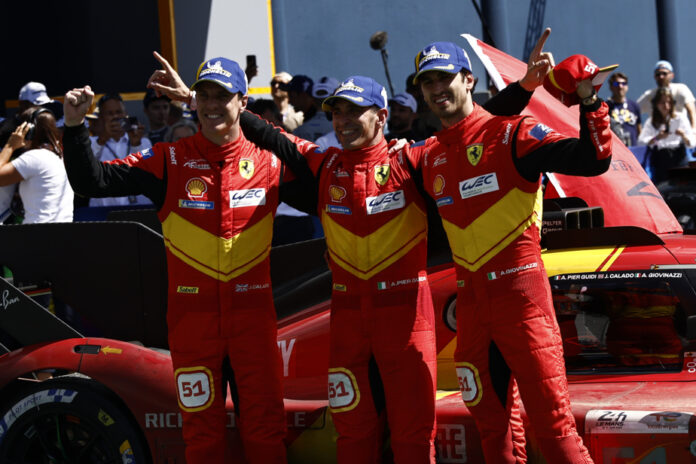(Le Mans) Ferrari pulled off a resounding comeback after a 50-year absence from the 24 Hours of Le Mans, ending Toyota’s five-year hegemony after a thrilling race to the finish.
A century after the first race on muddy roads in 1923, the 91st edition has lived up to its promise with the return of several historic manufacturers and real competition in all categories.
In Hypercar, the top class, the Ferrari N.51, driven by Italians Alessandro Pier Guidi and Antonio Giovinazzi and Briton James Calado, won ahead of the Toyota N.8, victorious last year (Sébastien Buemi, Ryo Hirakawa, Brendon Hartley) and the Cadillac N.2 (Earl Bamber, Alex Lynn, Richard Westbrook), relegated to two laps.
While the five main teams – Ferrari, Toyota, Cadillac, Peugeot and Porsche – took turns at the front in the early hours, the race turned overnight into a thrilling duel between Ferrari and Toyota.
The two cars were rarely more than 20 seconds apart and regularly changed position, until the Ferrari finally took the lead shortly before 11 a.m. (5 a.m. EST).
“We discovered the car last July, less than a year ago. So finding ourselves here was already something fantastic. And having an all-red front line…”, rejoiced Giovinazzi.
“We didn’t expect to survive 24 hours. We come back to Le Mans after 50 years and we win, we can be proud”. Ferrari wins its tenth title at Le Mans – the first since 1965.
Long in the wake of the Ferrari, the Toyota stalled 1:30 before the end of the race, when Hirakawa missed braking and hit a barrier. “He was told to attack everything he could,” Buemi explained, explaining that the Ferraris were “a bit quicker from the start.”
Upon arrival, tears of disappointment streamed down some faces in the Toyota stand. Especially since this week, the balance of performance (BoP), developed to balance the chances of the cars, had been modified this week to the detriment of the Japanese brand.
Winner this year of the first three rounds of the WEC, the world car endurance championship (Sebring, Portimao and Spa), Toyota was the favorite.
“I feel like we dominated the start of the year and there we weren’t really fighting or taking huge risks,” Buemi said. The Toyota N.7, winner in 2021, had to retire after a collision overnight.
“Changing the rules before the final is not done,” insisted Pascal Vasselon, technical director of Toyota Racing.
Behind, Cadillac, which hoisted its N.2 on the podium and its N.3, with Sébastien Bourdais at the wheel, in fourth place, carried out a very good operation, while the Ferrari N.50, which started in the lead position, finished fifth.
On the other hand, disappointment also for Porsche, which was aiming for a 20th coronation, but lost ground too quickly on Saturday evening. The Peugeots also played at the front for a time before suffering a series of incidents which relegated them to 8th and 11th places.
The fight was also close to the end in the LMP2 category (more standardized and slower prototypes), where the Polish team Inter Europol Competition won by 21 seconds.
In LMGTE Am (driven by amateurs paired with professionals), Corvette Racing’s Chevrolet came out on top, as only nine of the 21 cars entered in that class finished the race, five of them on the same lap.
In total, more than a third of the 62 cars entered did not finish, victims of a series of collisions and incidents, but also of a violent downpour which transformed part of the track into an ice rink on Saturday in late afternoon.
Despite the pessimistic weather forecast, at least for Saturday, some 325,000 spectators came from all over the world, according to the organizers who spoke of a record attendance.
“Between the television and that, it’s really two worlds,” said Charles-David Rosa-Matton, a 30-year-old Canadian from the exit of the Mulsanne bend, as the roar of the engines tore through the surrounding forest.















